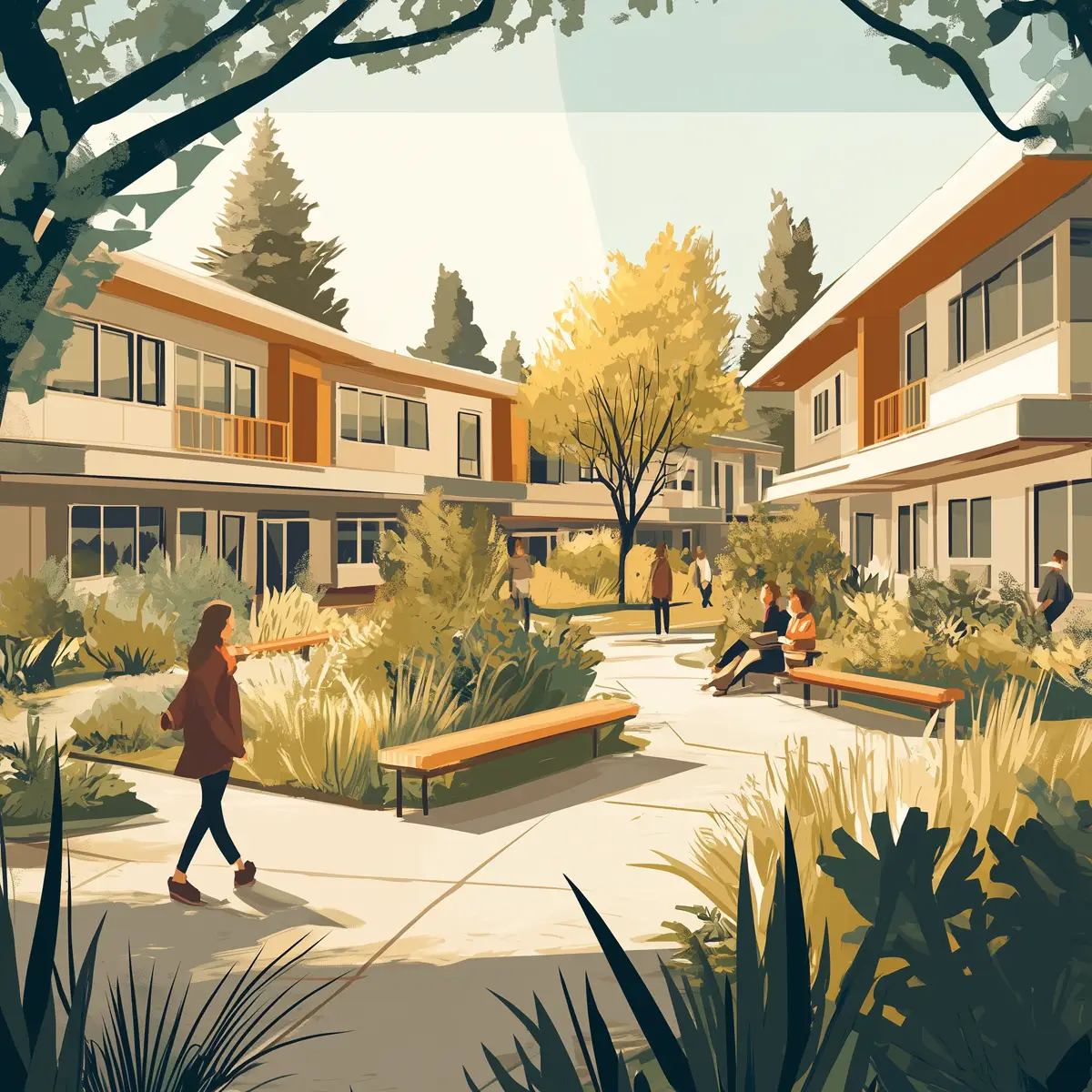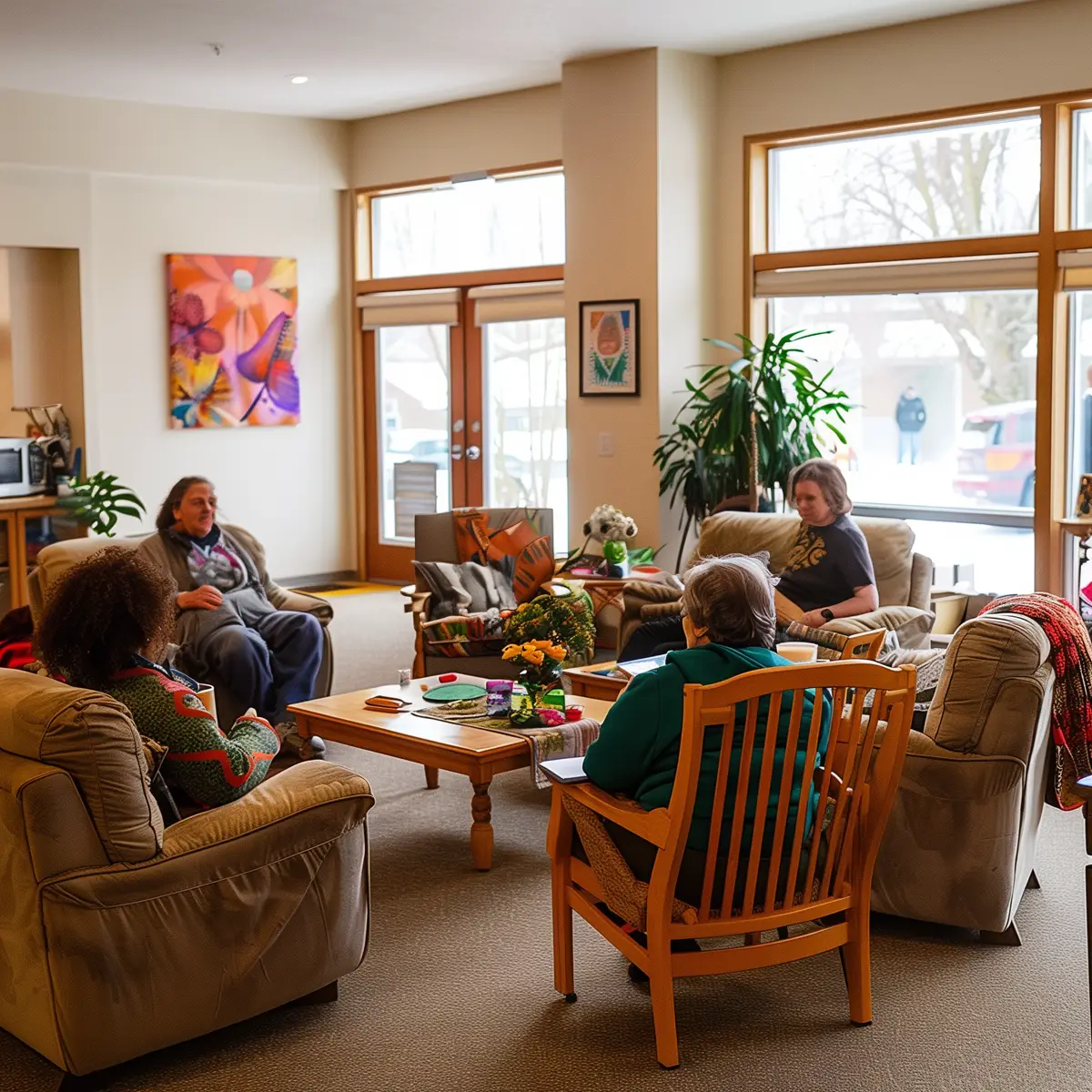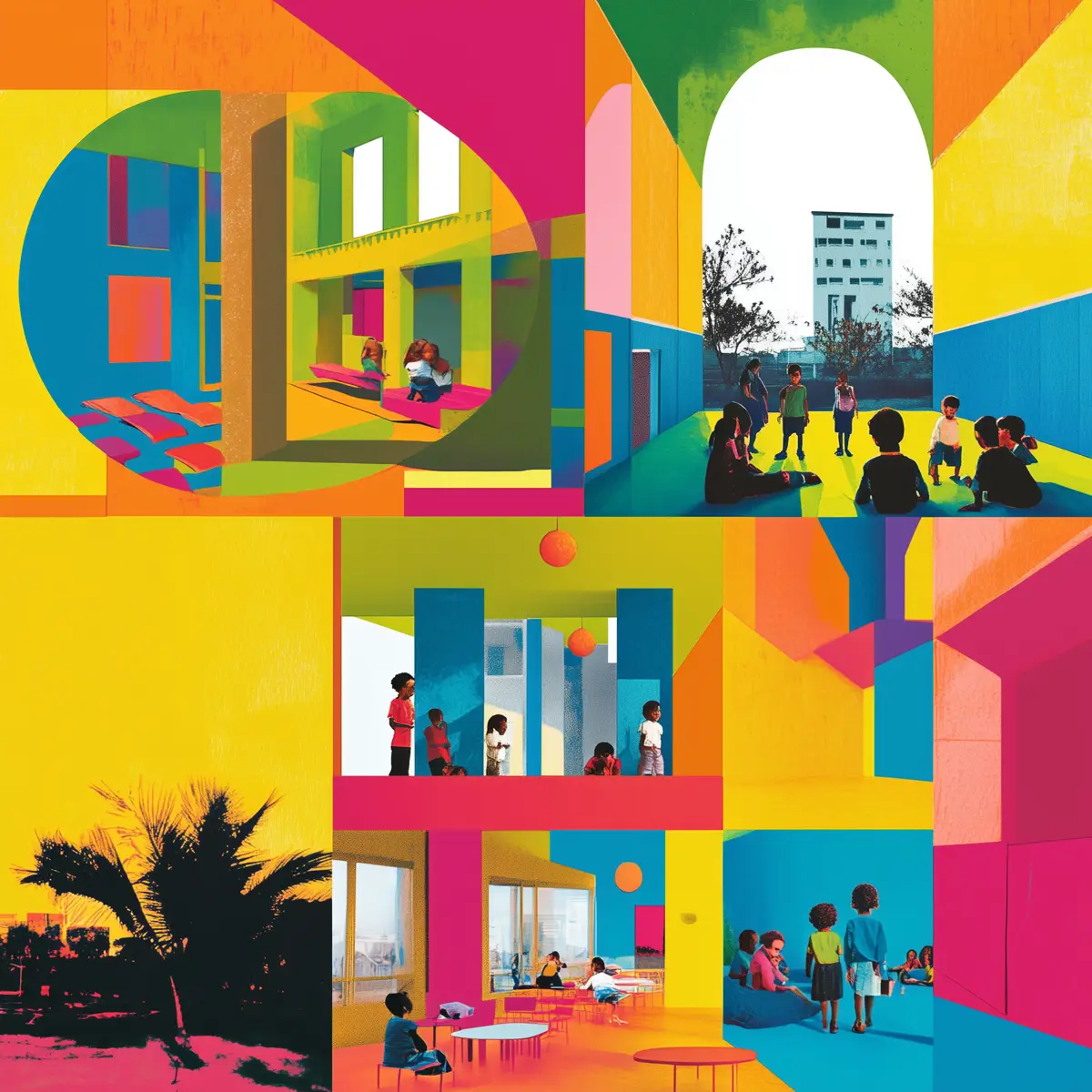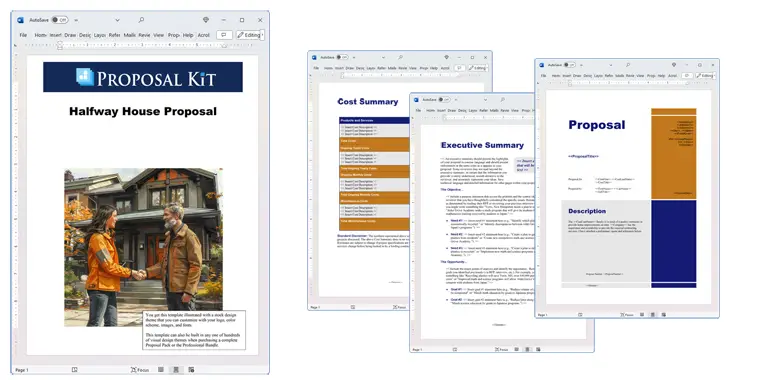How to write your Halfway House Proposal
We include this 28 page layout with every Proposal Pack. If you want this template to have a different visual design theme than the one illustrated here, purchase any Proposal Pack design and create this template using the purchased design theme. This template is included in every Proposal Pack. If you get a Proposal Pack or the Professional Bundle, you can also make any variation of this template with different chapters to suit your needs.
We typically include more chapters in the templates than most people will need to give everyone more variety in the chapters they may need. You can trim down a long template by removing pages you do not need or combining multiple chapter topics into one page.
 DOWNLOADABLE, ONE-TIME COST, NO SUBSCRIPTION FEES
DOWNLOADABLE, ONE-TIME COST, NO SUBSCRIPTION FEES If you need this template on DVD media order from our Amazon shop.
If you need this template on DVD media order from our Amazon shop.
You can also create countless variations of this document to suit your needs using the included library of 2200+ chapters if ordering a Proposal Pack or Pro Bundle.
 What Our Clients Say
What Our Clients SayI recently purchased one of your Proposal Packs. I must admit the proposal packs are excellent. You have successfully streamlined the process so that I can focus on the details of the content of the proposal."
Related Article
Related Video
Related Templates
- Transitional Housing Funding Proposal
- Group Home for People with Disabilities Proposal
- Orphanage Non-Profit Funding Support Proposal
- Homeless Womens Shelter Non-Profit Funding Proposal
- Church Mission Shelter Proposal
- Womens Center Funding Proposal
- Mens Center Funding Proposal
- Teen Center Funding Proposal
- Mental Health Grant Funding Proposal
- Transitional Housing Project Proposal
- Inmate Job Training Program Proposal
- Standard of Living Improvement Proposal
- Senior Home Care Proposal
What's the Best Way to Write Your Halfway House Proposal?
A proven way to approach this is by using Proposal Kit templates and software packages. These tools provide a structured, step-by-step guide to creating comprehensive and professional proposals. They incorporate a line item quoting database system for cost summaries, quotes, estimates, budgets, and other financial topics, ensuring your proposal is thorough and well-organized.
If you need to write a proposal to open a halfway house, the Proposal Kit includes the templates, layouts, and software you need. Understanding the components of a successful halfway house proposal can make this process easy.
What Types of Projects Are Halfway House Proposals Written For?
Opening a halfway house involves various projects with unique requirements and objectives. Here are some examples
- Establishing a residential facility for individuals transitioning from incarceration.
- Creating a program for substance abuse rehabilitation.
- Developing a mental health support residence.
- Setting up a halfway house for veterans.
- Opening a facility for homeless individuals.
- Implementing a support home for individuals with developmental disabilities.
- Creating a transitional housing program for young adults aging out of foster care.
- Establishing a reentry program for individuals recovering from addiction.
- Developing a halfway house for domestic violence survivors.
- Setting up a residential facility for individuals with chronic illnesses.
- Applying for grant funding for a halfway house.
Chapters this template is built with
Creating a halfway house proposal involves several key sections, each addressing different aspects of the project. While no one-size-fits-all template exists, the Proposal Kit offers an extensive library of customizable templates to fit your needs. Here are some essential components.
These chapters are just a small selection of the thousands of templates in the Proposal Kit's library, allowing extensive customization to cover all necessary topics. Using Proposal Kit's Word format documents, you can create examples and samples that, once edited, can be saved as PDF files for delivery.
Cover Letter
The cover letter introduces your proposal, providing an overview of your intentions and the importance of the halfway house project. It should be personalized to the recipient, concise, and engaging. For instance, highlight the critical need for a halfway house in your community to support individuals transitioning from incarceration. Explain how this facility will help reduce recidivism and promote successful reintegration.
Introduction
The introduction sets the stage for your proposal, explaining the purpose of the halfway house and the need it addresses in the community. For example, you can describe the current lack of support services for individuals with mental health issues or addiction problems in your area and how your halfway house will fill this gap by providing structured rehabilitation and reintegration programs.
Executive Summary
The executive summary briefly overviews the proposal, highlighting the key points and objectives. It should encapsulate your vision for the halfway house, including the types of therapies and support services offered, the target population, and the expected outcomes. This summary is a snapshot for stakeholders to understand the project's scope and benefits quickly.
Goals and Objectives
This section outlines the specific goals and objectives of the halfway house, detailing what you aim to achieve and how you plan to do it. For example, you might seek to reduce homelessness among veterans over the next five years through targeted support and housing. Clearly defined goals and measurable objectives help demonstrate the feasibility and impact of your project.
Compliance Plan
The compliance plan describes how the halfway house will adhere to local, state, and federal regulations, ensuring all legal requirements are met. This might include obtaining necessary licenses, meeting zoning laws, and adhering to health and safety standards. Detailing your plan to comply with these regulations helps build trust and credibility with stakeholders.
Staffing
This section details the staffing needs for the halfway house, including roles, responsibilities, and qualifications. For example, you might outline the need for licensed counselors, social workers, and security personnel. Providing a detailed staffing plan shows that you have considered all aspects of running the halfway house effectively.
Supervision
Supervision outlines the oversight and management structure, ensuring the safety and effectiveness of the halfway house operations. This could include detailing the supervisors' roles, qualifications, and protocols for monitoring staff performance and resident progress. Effective supervision is crucial for maintaining a safe and supportive environment.
Therapies
Therapies provided at the halfway house should be detailed, including types of treatment, frequency, and the professionals involved. For instance, you might offer cognitive-behavioral therapy (CBT) sessions twice a week, facilitated by licensed therapists. Specific therapy information helps stakeholders understand how residents will receive their needed support.
Rehabilitation
This section discusses rehabilitation programs and activities aimed at helping residents reintegrate into society. These include job training, life skills workshops, and educational programs. Describing these programs demonstrates how your halfway house will equip residents with the tools they need to succeed independently.
Counseling
Here, you describe the counseling services available to residents, including individual and group sessions. You might detail how residents can access one-on-one counseling for personal issues and participate in group sessions to build community and peer support. Comprehensive counseling services are an essential part of holistic care.
Public Comments
Public comments address community feedback and concerns, showing how you have engaged with and plan to address local opinions. This could involve detailing the public forums you held, the feedback received, and your plans to integrate this feedback into your proposal. Engaging with the community builds trust and support for your project.
Safety
This section outlines safety measures, including protocols for emergencies and day-to-day security. For example, describe your emergency response plan, the installation of security cameras, and regular safety drills. Ensuring safety is paramount to gaining approval and maintaining a secure environment for residents and staff.
Security
Security plans detail how the halfway house will ensure the safety of residents, staff, and the community. This could include hiring trained security personnel, implementing controlled access to the facility, and establishing strict visitor protocols. A robust security plan reassures stakeholders about the halfway house's safety and integrity.
Regulations
This section covers the regulations the halfway house must comply with, ensuring all legal aspects are addressed. List the local health department requirements, housing standards, and any specific rules related to halfway houses. Thoroughly addressing regulations ensures your proposal meets all necessary legal standards.
Location
The location section explains why the chosen site is suitable for the halfway house, including zoning and community impact. You might discuss the accessibility of public transportation, proximity to hospitals or job centers, and community support. Choosing the right location is critical for the halfway house's success and acceptance.
Objections
Potential objections to the halfway house are acknowledged and addressed, showing proactive planning and community engagement. For example, address increased traffic or safety concerns by detailing your traffic management plan and security measures. Addressing objections transparently helps mitigate opposition and builds community trust.
Community
Community involvement and support strategies are detailed, highlighting how the halfway house will integrate with and benefit the local area. This might include partnerships with local businesses, volunteer opportunities, and public awareness campaigns. Strong community ties are essential for the halfway house's success and sustainability.
Budget
A comprehensive budget outlines all financial aspects, including funding sources, expenses, and financial management plans. You might detail the costs for staffing, facilities, and programs, as well as projected revenue from grants and donations. A detailed budget demonstrates financial responsibility and feasibility.
Experience
The experience section showcases the qualifications and track records of the individuals or organizations behind the halfway house. This could include previous successful projects, relevant professional experience, and awards or recognition. Highlighting experience builds credibility and confidence in your ability to execute the project.
Capacity
Capacity details the number of residents the halfway house can accommodate and the resources available to support them. For example, explain how the facility can house a specific number of residents with sufficient staff to provide individualized care. Precise capacity planning ensures the halfway house can meet its goals without overstretching resources.
About Us
This section provides background information about the organization or individuals proposing the halfway house, building credibility and trust. You might include your mission statement, history, and core values. Providing a solid organizational background helps stakeholders understand your commitment and capability.
Certifications
Certifications and accreditations relevant to the halfway house operations are listed, showcasing adherence to standards. These include staff certifications, facility accreditation, and any industry-specific standards. Certifications demonstrate a commitment to quality and compliance.
Facilities
This section provides an overview of the physical facilities, including housing, therapy rooms, and communal areas. It also describes the residence's layout, the availability of private and shared rooms, and the amenities provided. Detailed facility descriptions help stakeholders visualize the environment and its suitability.
Confidentiality
Confidentiality policies ensure the privacy and protection of residents' personal information. This could include detailing how resident records are stored securely, staff training on confidentiality, and protocols for handling sensitive information. Strong confidentiality policies are essential for building trust and ensuring compliance with legal standards.
Policies
General policies governing the halfway house operations, including rules and procedures, are detailed. This might include house rules for residents, staff conduct policies, and methods for handling grievances. Clear and comprehensive policies help ensure smooth and consistent operations.
Use cases for this template
Securing Funding for a Veteran Halfway House
John, a small business owner, was passionate about opening a halfway house for veterans in his local community. He recognized the critical need for a supportive environment to help veterans transition back into civilian life, addressing issues like PTSD and reintegration challenges. John needed a comprehensive proposal to secure funding and community support to achieve this.
John turned to the Proposal Kit for guidance. Using the extensive library of templates, he created a detailed proposal that included rehabilitation services tailored to veterans, detailed security plans to ensure safety, and a robust compliance plan to meet all legal requirements. The structured templates allowed him to cover every necessary aspect, from staffing and supervision to community engagement and budget planning.
With the professional and compelling proposal created using the Proposal Kit, John secured the necessary funding and gained strong community support. This allowed him to open the halfway house, providing a vital resource for needy veterans.
Meeting a Deadline for a Homeless Support Halfway House
Sarah, an employee at a non-profit organization, was assigned to write a proposal for a halfway house to support homeless individuals. Sarah needed to create a comprehensive proposal that addressed all critical areas, including public comments and safety measures.
Sarah turned to Proposal Kit for help. Leveraging comprehensive templates and an AI writing tool, she efficiently created specific chapters by analyzing her company's website for relevant content. This combination of resources enabled her to meet the deadline with a well-written proposal.
Sarah's proposal was instrumental in securing approval for the project. It addressed all necessary components, from community feedback to detailed safety plans, ensuring the halfway house would be a safe and supportive environment for homeless individuals. The success of this project highlighted Sarah's ability to leverage technology and structured templates to meet challenging deadlines and achieve outcomes.
Creating an RFP for a Domestic Violence Survivor Halfway House
Michael, a director at a non-profit organization, was tasked with creating a Request for Proposal (RFP) for setting up a halfway house for domestic violence survivors. He needed to develop a detailed and thorough RFP that would attract high-quality responses from potential partners.
Using the Proposal Kit, Michael developed an RFP that covered all necessary components. The structured templates allowed him to include detailed sections on staffing requirements, community integration plans, security measures, and compliance with regulations. Each section was carefully created to ensure clarity and completeness.
The well-structured RFP attracted several high-quality responses from potential partners, leading to the successful establishment of the halfway house. This facility now provides a safe and supportive environment for survivors of domestic violence, helping them rebuild their lives. Michael's use of the Proposal Kit was key to creating an effective RFP, demonstrating the power of well-organized and detailed documentation.
Conclusions and Recommendations
Writing a halfway house proposal with the right tools becomes manageable. Using Proposal Kit templates and software packages, you can create a detailed and professional proposal that addresses all necessary components, from compliance plans to community engagement. By leveraging these tools, you can ensure your halfway house proposal is comprehensive, persuasive, and tailored to meet the unique needs of your project.
Also Known As
This template may also be referred to in different ways or be used in more specialized situations, such as:
- Transitional Housing Proposal
- Rehabilitation Center Proposal
- Community Reentry Program Proposal
- Supportive Housing Proposal
- Reintegration Facility Proposal
- Recovery Home Proposal
- Transitional Living Program Proposal
- Therapeutic Community Proposal
- Sober Living House Proposal
- Reentry Support Proposal
Abstract
 Creating a successful halfway house proposal requires meticulous planning and using various community resources and partnerships. A business plan for a proposed halfway house must address important components, such as financial projections, compliance with local zoning laws, and the integration of trauma-informed care. By collaborating with community leaders, social service agencies, and healthcare providers, halfway house operators can ensure that they are meeting the needs of specific demographics, such as veterans, individuals released from prison, or those recovering from addiction. A thorough financial model, including a cash flow statement and balance sheet, is crucial for attracting residents and securing funding from private foundations or government agencies.
Creating a successful halfway house proposal requires meticulous planning and using various community resources and partnerships. A business plan for a proposed halfway house must address important components, such as financial projections, compliance with local zoning laws, and the integration of trauma-informed care. By collaborating with community leaders, social service agencies, and healthcare providers, halfway house operators can ensure that they are meeting the needs of specific demographics, such as veterans, individuals released from prison, or those recovering from addiction. A thorough financial model, including a cash flow statement and balance sheet, is crucial for attracting residents and securing funding from private foundations or government agencies.
Moreover, the halfway house should provide job training and employment opportunities to clients, aiding them in gaining independence and achieving a sense of well-being. Safety features like fire alarms, emergency exits, and regular inspections are necessary for compliance with safety regulations. Offering services such as individual counseling and group therapy sessions can support emotional recovery and relapse prevention.
Engaging with community organizations and educational institutions can help in forging referral networks, while understanding local market research is vital for identifying the ideal location and potential residents. By focusing on these topics, a halfway house proposal can serve as a powerful tool in successfully reintegrating individuals into the community while addressing their holistic needs.
 A halfway house business plan acts as a blueprint, guiding the development of facilities that support individuals transitioning from incarceration or addiction recovery. By employing comprehensive business planning practices, these plans facilitate the establishment of treatment facilities that offer important services and emotional support, fostering independent living and well-being among residents. Collaborating with community partners, such as social services, educational institutions, and healthcare providers, is in creating a robust referral network and ensuring the provision of similar services that cater to the diverse needs of community members.
A halfway house business plan acts as a blueprint, guiding the development of facilities that support individuals transitioning from incarceration or addiction recovery. By employing comprehensive business planning practices, these plans facilitate the establishment of treatment facilities that offer important services and emotional support, fostering independent living and well-being among residents. Collaborating with community partners, such as social services, educational institutions, and healthcare providers, is in creating a robust referral network and ensuring the provision of similar services that cater to the diverse needs of community members.
The use of Proposal Kit enhances the efficiency of creating detailed business plans, offering templates that incorporate thorough research and financial assessments to determine the project's viability. Conducting background checks and safety assessments ensures the security of both the facility and the surrounding neighborhood, addressing any concerns raised by neighbors. Identifying a suitable property involves evaluating local zoning laws and securing necessary permits, while financial planning must account for staff salaries, operational expenses, and potential income sources, including grants and personal savings.
These facilities serve as a first step toward positive growth and reintegration for individuals with criminal backgrounds, offering job opportunities and skill development to promote gainful employment. A holistic approach that includes trauma-informed care and support for families ensures that client rights are upheld and that the transition process is compassionate and effective. Additionally, addressing the needs of specific demographics, such as women and mothers, requires tailored programs that encourage personal development and emotional stability.
 Beyond the immediate impact on participants, halfway house projects contribute to broader societal benefits, such as reduced recidivism and enhanced public safety. By fostering an environment of support and understanding, these facilities enable individuals to successfully reintegrate into society, transforming lives and strengthening community bonds. Engaging in open dialogue with community members through forums and blog posts can further promote awareness and support for the initiative, ultimately realizing a vision of inclusive growth and rehabilitation.
Beyond the immediate impact on participants, halfway house projects contribute to broader societal benefits, such as reduced recidivism and enhanced public safety. By fostering an environment of support and understanding, these facilities enable individuals to successfully reintegrate into society, transforming lives and strengthening community bonds. Engaging in open dialogue with community members through forums and blog posts can further promote awareness and support for the initiative, ultimately realizing a vision of inclusive growth and rehabilitation.
Developing a halfway house involves comprehensive planning and partnerships to address the multifaceted needs of residents transitioning from prisons or drug rehabilitation programs. The commitment to trauma-informed care ensures that staff members are equipped to handle the emotional complexities associated with past traumas, fostering a nurturing environment that promotes the well-being of all individuals. Conducting research and forging robust partnerships with local schools, corrections departments, and community organizations are important to creating a supportive network that caters to the unique needs of inmates and incarcerated individuals.
Financial planning is a cornerstone of any proposal, requiring a detailed evaluation of financial needs, including securing funding from banks or investors and managing loans and grants. A well-researched financial strategy helps maintain an operational balance, ensuring that services are sustainable and capable of meeting future demands. To further enhance the proposal's viability, the integration of safety features such as secure entry systems and adherence to local guidelines ensures the safety of both residents and the surrounding community.
 Understanding the socioeconomic factors that influence behavior and rehabilitation outcomes is critical for creating effective programs. Addressing the specific needs of children and families involved in the corrections system, for instance, can reduce the cycle of incarceration and provide a positive impact on family dynamics. By examining case studies and analyzing data, halfway house operators can tailor their services to align with best practices, ensuring that the transition from incarceration to community living is seamless and supportive.
Understanding the socioeconomic factors that influence behavior and rehabilitation outcomes is critical for creating effective programs. Addressing the specific needs of children and families involved in the corrections system, for instance, can reduce the cycle of incarceration and provide a positive impact on family dynamics. By examining case studies and analyzing data, halfway house operators can tailor their services to align with best practices, ensuring that the transition from incarceration to community living is seamless and supportive.
Moreover, establishing referral sources and maintaining strong relationships with service providers, including those offering food and healthcare assistance, are vital for a holistic approach. This inclusive model not only addresses immediate needs but also lays the groundwork for long-term success and community reintegration. By prioritizing the development of important life skills, job training, and educational opportunities, halfway houses can prepare residents for gainful employment, reducing the likelihood of re-offending and contributing to a healthier community.
Finally, a proactive approach to overcoming societal barriers, such as discrimination and systemic inequities, is necessary to promote inclusivity and equity. Encouraging open dialogue and community engagement can help reshape perceptions, build trust, and highlight the positive contributions of halfway houses to the broader social fabric. By focusing on these critical topics, halfway houses can realize their potential as transformative agents of change, ensuring that all individuals have the opportunity to thrive and contribute to their communities.
Frequently Asked Questions
What is the best way to start writing a halfway house proposal?
Using Proposal Kit's structured templates and software is the best way to start writing your halfway house proposal. These resources guide you through each section, ensuring you cover all critical aspects.
How can Proposal Kit help me address community objections in my halfway house proposal?
The Proposal Kit includes specific templates for addressing public comments and objections. These templates help you engage with the community and provide detailed plans to mitigate concerns.
Can I customize the templates provided by the Proposal Kit to fit my specific needs?
Yes, Proposal Kit's templates are highly customizable, allowing you to tailor each section to fit the unique requirements of your halfway house project.
How does Proposal Kit assist with the financial aspects of the proposal?
Proposal Kit includes a line item quoting database system that helps you create detailed cost summaries, quotes, estimates, and budgets, ensuring your financial plans are thorough and accurate.
What format are the Proposal Kit templates in, and how can I deliver the final proposal?
The templates are in Word format, making them easy to edit. Once you have completed your proposal, you can save it as a PDF for delivery.
15% Off Discount
![]() Add To Cart This Word Template Only
Add To Cart This Word Template Only
 Add To Cart Proposal Pack for Any Business
Add To Cart Proposal Pack for Any Business
 Add To Cart Proposal Kit Professional Bundle
Add To Cart Proposal Kit Professional Bundle
 4.7 stars, based on 846 reviews
4.7 stars, based on 846 reviewsProposal Kit chapters used in this template
Cover Letter, Title Page, Table of Contents, Introduction, Executive Summary, Goals and Objectives, Location, Community, Public Comments, Objections, Safety, Security, Facilities, Capacity, Staffing, Supervision, Therapies, Rehabilitation, Counseling, Regulations, Compliance Plan, Budget, About Us, Experience, Certifications, Confidentiality, Policies, Back Page
Included Calculator Spreadheets
These Excel calculator spreadsheets are included with this template. If you purchase a Proposal Pack or the Professional Bundle, these proposal pages are generated using an automated line-item database in the included Wizard software. The calculator spreadsheets are intended for use when purchasing only the static Word template.
You use this proposal for
- General business proposal
- Non-technical proposal
- Project pitch proposal
- Non-government grant, non-profit, NGO proposal
- Spiritual, church, community proposal
How to create this template with Proposal Pack Wizard
You can create this document using any of the logo-designed Proposal Packs. Pick any Proposal Pack with a logo design theme you like best; they will all work equally well. The Proposal Pack for Any Business is the pack with no extra added logos or colors - designed to be used plain or for you to customize with your logos and graphics.
The Proposal Pack design theme you purchase will determine the visual look of this template. The screenshot above only shows the plain generic design theme. Names and stories in examples are fictional; however, the templates are from real client use cases.
We include a library of chapters to be assembled based on your needs. All proposals are different and have different needs and goals. We designed Proposal Pack so you can customize the documents to suit your needs.
You will best create this document using the Proposal Pack Wizard - Expert Edition software to select this template and build it in the Proposal Pack logo design theme of your choice along with any desired customizations (such as adding additional chapters, removing unneeded chapters, changing the order of chapters, and importing your company logo). This template outlines a proposal for the described situation. Each user is responsible for typing in the actual content of the provided pages with their information to complete the proposal. Suggestions in the abstract may include features in higher-end packages and are facilitated by the selection of chapter templates to support the narrative of each proposal, which help guide the user in filling in the details.
You create this template using the Wizard software with an entire Proposal Pack library and software. We include the Expert Edition of the software in the Proposal Kit Professional bundle. Microsoft Word for Windows is required to use the customizing software. You can also edit Word document templates in other office software such as Word for Mac. We will assist Mac users in assembling complex templates for their first project if they do not have the required platform to run the Wizard software.
You only get the single assembled Word document if purchased as a stand-alone template. The individual template products include no other templates, samples, or software.
How to Build Templates Featured on Proposal Kit Website
Many people find the Proposal Kit website after searching for a specific proposal. Once you've purchased and installed the software, how do you build that template you found in the first place? This video shows you how to build any proposal you see on the Proposal Kit website.
Key Takeaways
- The Halfway House Proposal is available as a ready-to-edit template.
- You can create unlimited custom variations of this template using a Proposal Pack or the Professional Bundle.
- Using a Proposal Pack or Professional Bundle, you can automate quotes and other financial pages with a line-item database.
- There are no ongoing subscription fees. You get lifetime unlimited use.
- We made Proposal Kit for freelancers, small businesses, and non-profits.
- Proposal Kit product content (templates, samples, software) is 100% written by humans.
 Ian Lauder has been helping businesses write their proposals and contracts for two decades. Ian is the owner and founder of Proposal Kit, one of the original sources of business proposal and contract software products started in 1997.
Ian Lauder has been helping businesses write their proposals and contracts for two decades. Ian is the owner and founder of Proposal Kit, one of the original sources of business proposal and contract software products started in 1997.By Ian Lauder
 Published by Proposal Kit, Inc.
Published by Proposal Kit, Inc.


 Cart
Cart


 Get 15% off ordering today:
Get 15% off ordering today: 

 Facebook
Facebook YouTube
YouTube X
X Search Site
Search Site